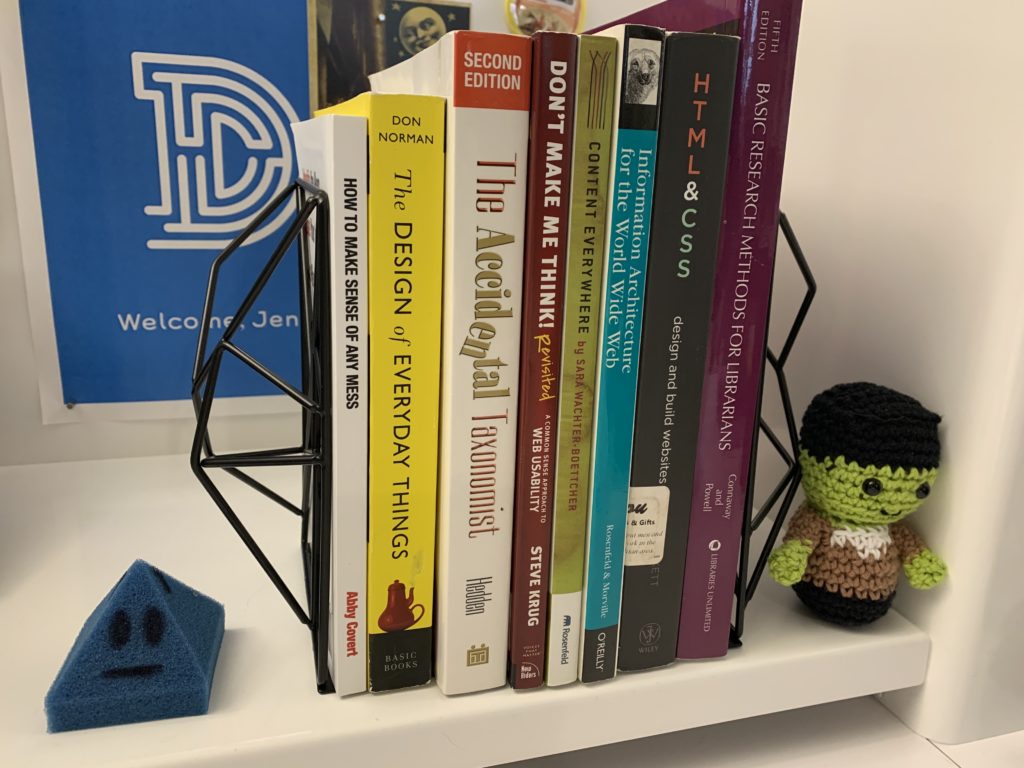
As a relatively new UX/UI designer, I’m always on the lookout for great resources for learning more about the field. And between online training modules, YouTube tutorials, and UX design blogs, there are so many fantastic sources of information and education online that I’m spoiled for choice!
Still, there is a part of me (likely the part that went to library school) that appreciates the value of a well-curated personal work reference library. The internet is a wonderful place for quick answers and specific how-tos, but when it comes to the slower work of building up a foundational knowledge base, one good, comprehensive book can work wonders.
Though I’m fairly new to the profession, I think my tabletop design library is starting to come along nicely. Here are the eight books that live on my desk:
-
How to Make Sense of Any Mess by Abby Covert
This is the newest addition to my library, but it is already one of my favorites—it is like Zen Koans for information architecture. I read the whole thing in one sitting and return to it often. The structure of the book is designed for quick reference and the cadence of the writing is almost meditative in its straightforward plain-spokenness—the ideal format for such a broadly applicable work.
-
The Design of Everyday Things by Don Norman
Do I even need to describe this one? This is LITERALLY the textbook in many Human-Computer Interaction classes, which is exactly how I came by my copy. It is impossible to overstate how influential this work has been on the field of design.
This book, informed heavily by Norman’s background in cognitive psychology, established the concept of design “affordances” and helped bring the term user-centered design to the forefront of the field, shifting the onus back onto designers to design products that naturally discourage usage errors.
-
The Accidental Taxonomist (Second Edition) by Heather Hedden
I picked up this book for a class in library school, and after finishing it, I don’t believe it would be an understatement to say that this is quite possibly the most comprehensive resource I’ve come across for getting started learning the incredibly valuable skill of organizing and categorizing information effectively and efficiently. This book definitely leans heavier on the information architecture end of the UX spectrum, but it is broadly accessible enough to have a little something for everybody.
-
Don’t Make Me Think (Revisited): A Common Sense Approach to Web Usability by Steve Krug
Another oft-cited design classic and with good reason. At just 200 pages long (and that’s counting the table of contents and index!), this book economically packs an incredible amount of information into a very small space and makes it look absolutely effortless. No matter which edition you’re reading, this book is a fantastic primer for new design professionals as well as an accessible and surprisingly fun read for pretty much anyone who happens to pick it up.
-
Content Everywhere by Sara Wachter-Boettcher
In a rare moment of raffle-based luck, I won my copy of this book in a prize drawing at a digital marketing conference a few years ago. When I finally got around to reading it, I was floored by its scope—this book is useful not only to content strategists, but to writers, marketers, designers, and pretty much anyone else who slings words or images on the internet today. In an age defined by frenetic information overload, there is comfort (and utility) in reading about logically structured, modular content and design systems and how one can create and maintain them.
-
Information Architecture for the World Wide Web (First Edition) by Louis Rosenfeld & Peter Morville
Full disclosure: I picked up my copy of this book in a thrift store; it is the first edition from 1998. And you know what? Glossing over any mentions of AltaVista and Netscape, the core information on how to design the necessary architecture to design and build user-friendly interfaces is just as illuminating today as it likely was more than 20 years ago. There’s a reason why this classic is now on its fourth edition—now called Information Architecture for the Web and Beyond.
-
HTML & CSS: design and build websites by Jon Duckett
If I hadn’t had to purchase this for a class, chances are I would have picked up a copy of this book eventually—it was already on my Amazon wish list! Even for those in non-coding roles, this gorgeous visual reference for basic HTML/CSS provides a lot of valuable context for how web elements come together and present on a page.
-
Basic Research Methods for Librarians (Fifth Edition) by Lynn Silipigni Connaway and Ronald R. Powell
Even though this is a library science textbook (and priced accordingly), this book turned out to be such a useful primer and reference on the core tenets of research methodology that it is an honored member of my desktop design library.
The information in this book may be old hat for those with science backgrounds, but for designers coming from a liberal arts background, it does a tremendous job of detailing what you need to know in order to design good survey instruments and execute them ethically and effectively.
So, what must-read books are in your design library? Let me know—I love recommendations!
